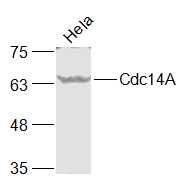产品货号 : mlR8614
英文名称 : Cdc14A
中文名称 : 细胞周期调控因子14A抗体
别 名 : CDC 10; Cdc 14; Cdc 14A; Cdc 14A1; Cdc 14A2; CDC10; Cdc14; CDC14 cell division cycle 14 homolog A; CDC14 homolog A; Cdc14A1; Cdc14A2; Cell division cycle 14 homolog A; Dual specificity protein phosphatase CDC 14A; Dual specificity protein phosphatase CDC14A; hCDC14; CC14A_HUMAN.
研究领域 : 细胞生物 信号转导 细胞周期蛋白 激酶和磷酸酶 表观遗传学
抗体来源 : Rabbit
克隆类型 : Polyclonal
交叉反应 : Human, Mouse, Rat, Dog, Cow, Horse, Sheep,
产品应用 : WB=1:500-2000 ELISA=1:500-1000 IHC-P=1:400-800 IHC-F=1:400-800 ICC=1:100-500 IF=1:100-500 (石蜡切片需做抗原修复)
not yet tested in other applications.
optimal dilutions/concentrations should be determined by the end user.
分 子 量 : 67kDa
细胞定位 : 细胞核 细胞浆
性 状 : Lyophilized or Liquid
浓 度 : 1mg/ml
免 疫 原 : KLH conjugated synthetic peptide derived from human Cdc14A:51-150/594
亚 型 : IgG
纯化方法 : affinity purified by Protein A
储 存 液 : 0.01M TBS(pH7.4) with 1% BSA, 0.03% Proclin300 and 50% Glycerol.
保存条件 : Store at -20 °C for one year. Avoid repeated freeze/thaw cycles. The lyophilized antibody is stable at room temperature for at least one month and for greater than a year when kept at -20°C. When reconstituted in sterile pH 7.4 0.01M PBS or diluent of antibody the antibody is stable for at least two weeks at 2-4 °C.
PubMed : PubMed
产品介绍 : In budding yeast, the Cdc14a phosphatase activates mitotic exit by dephosphorylation of specific cyclin-dependent kinase (Cdk) substrates and seems to be regulated by sequestration in the nucleolus until its release during mitosis. Human Cdc14a phosphatase is highly similar to Saccharomyces cerevisiae Cdc14 and is a member of the dual specificity protein Tyrosine phosphatase family. It interacts with and dephosphorylates tumor suppressor protein p53 and may regulate the function of p53. In addition, Cdc14a dephosphorylates hCdh1 and activates APCCdh1. Cdc14a phosphatase plays a role in the regulation of the centrosome cycle, mitosis and cytokinesis, thereby influencing chromosome partitioning and genomic stability in human cells. Deregulated human Cdc14a phosphatase disrupts centrosome separation and chromosome segregation.
Function:
Overproduction of hCdc14A leads to progressive cell death, accompanied by accumulation of pre-G1 DNA fragments and gradual elimination of cells at the G2/M transition. In 50% of the mitotic cells, multipolar mitotic spindles and misaggregated chromosomes are found. hCdc14A localizes to the centrosomes at the cell-cycle interphase stage. When the cell enters mitosis, this localization disappears suggesting that hCdc14A dissociates from the centrosomes at the G2/M transition. hCdc14A localizes to interphase centrosomes, but not to mitotic centrosomes, while hCdc14B localizes to the interphase nucleolus. Thus each isoform regulates separate cell cycle events. Cdc14A may affect cell cycle progression by its ability to dephosphorylate p53 at Ser315. This phosphatase activity is mediated by the interaction between the N-terminus of hCdc14A and the C-terminus of p53.
Subunit:
Interacts with KIF20A, which is required to localize CDC14 to the midzone of the mitotic spindle.
Subcellular Location:
Nucleus. Cytoplasm, cytoskeleton, centrosome. Cytoplasm, cytoskeleton, spindle. Note=Centrosomal during interphase, released into the cytoplasm at the onset of mitosis. Subsequently localizes to the midzone of the mitotic spindle.
Tissue Specificity:
Widely expressed.
Similarity:
Belongs to the protein-tyrosine phosphatase family. Non-receptor class CDC14 subfamily.
SWISS:
Q9UNH5
Gene ID:
8556
Important Note:
This product as supplied is intended for research use only, not for use in human, therapeutic or diagnostic applications.
产品图片












